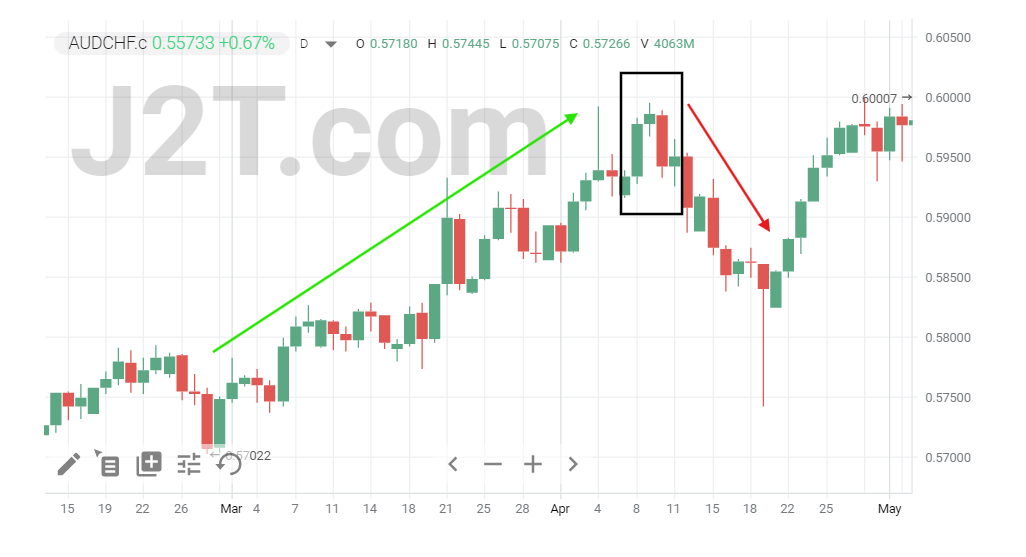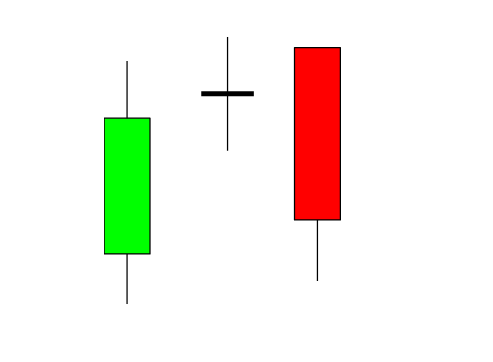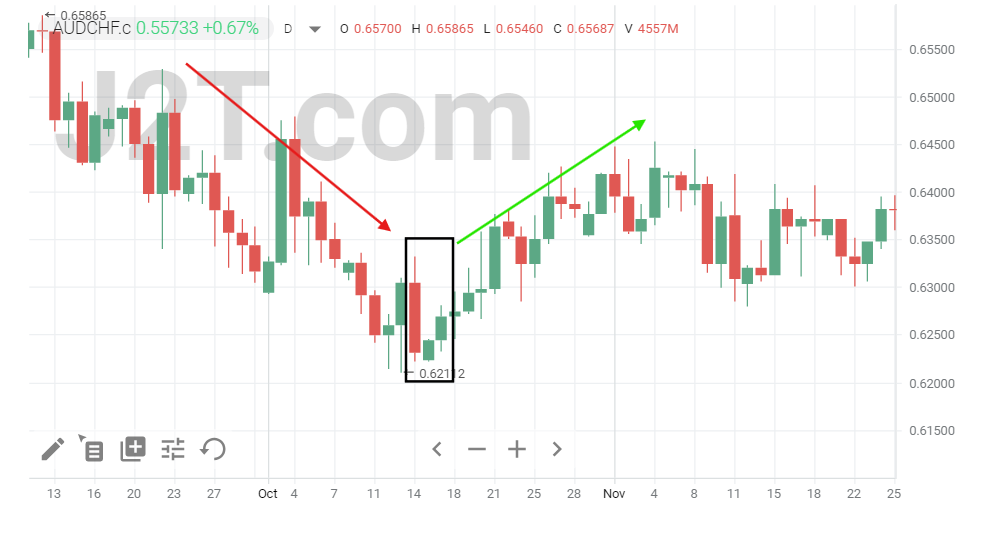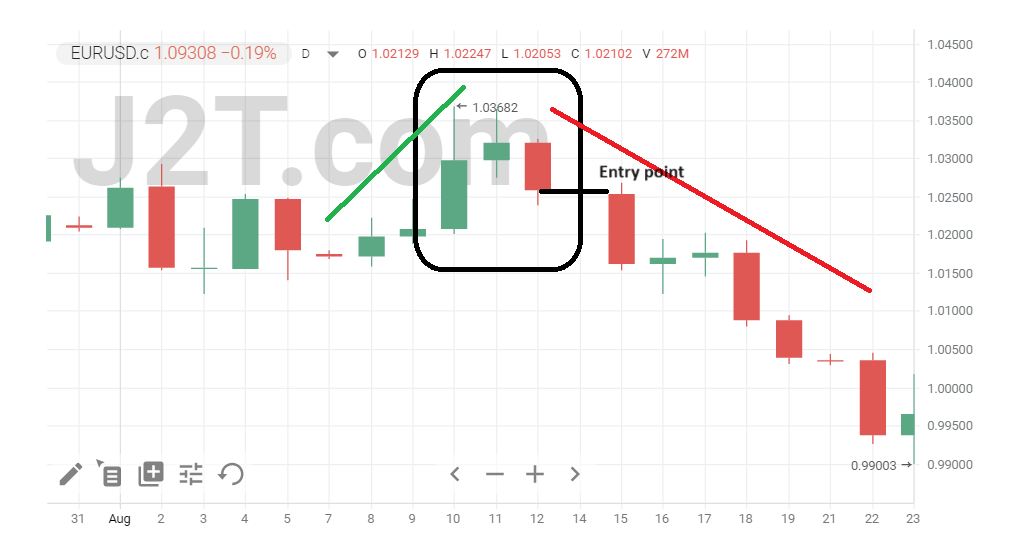Evening Star Candlestick Pattern: What It Is, How to Trade, and Examples
 (2))
Are you looking to enhance your trading strategy with reliable indicators? Evening star formation could be one of the keys. It’s a candlestick pattern with three candles indicating a potential bearish reversal. Let’s dive into the details of this robust tool's formation and trading nuances in our guide.
Table of Contents
Key Takeaways
What is an Evening Star Candlestick Pattern?
How to Identify an Evening Star on Forex Charts
Special Considerations
What Is the Morning Star?
How to Trade the Evening Star Candlestick Pattern
Trading Example
How Reliable is the Evening Star in Forex Trading?
Conclusion
FAQs
Key Takeaways
-
Evening star pattern is a tool of technical analysis usually found at the end of the uptrend.
- It is a three-candle pattern that signals a potential trend reversal from upward to downward.
- Best efficiency when combined with other technical analysis tools like oscillators, moving averages, volume indicators, and more.
- The opposite of the evening star is the morning star pattern that can be spotted at the end of the downtrend.
What is an Evening Star Candlestick Pattern?
The evening star candlestick pattern is a bearish reversal formation, which is typically noticed at the top of an uptrend. It indicates that the bullish momentum is getting weaker, and, as a result, a potential downtrend might be coming soon.
Formation of Evening Star Candlestick Pattern
The ideal evening star pattern forms with three candles:
-
The first is a strong bullish (green) candle. It signals an ongoing upward price move.
- The second candle is small and reflects market indecision.
- The third candle is bearish (red) and closes well into the first candle’s body, confirming the reversal.
How to Identify an Evening Star on Forex Charts

Spotting an evening star candlestick pattern is all about observation and detailed analysis. We have gathered key steps to follow to make this process easier.
-
Look for an upward trend with strong bullish candles indicating a consistent rise. Remember that the first candle in our pattern is a long bullish one that signals that the bulls are in charge.
- Search for a tiny candle with a small body that can show bullishness, bearishness, or indecision in the market.
- The third candle, a long bearish one, is the changing one. It opens below the close of the second candle and plunges deeply into the territory of the first candle.
This combination suggests a change from positive to negative market sentiment, indicating a rise in selling pressure and a possible downward trend.
Evening Star Doji

The evening star doji is a variation of the evening star pattern. In this case, the second candle is a doji, with a small body and long shadows (wicks), meaning the market's uncertainty is even higher. This doji signals that the bullish momentum is significantly diminishing and a more powerful bearish reversal may take place. This technical analysis formation underlines traders' doubts and suggests an approaching change towards a negative attitude.
Special Considerations
Trading the evening star candlestick pattern comes with its challenges. Although the evening star is considered a robust and quite reliable indicator, be careful about false signals that can occur, especially in volatile markets. To mitigate risks and avoid high potential losses, confirm this pattern with other technical indicators like volume or moving averages. Be patient and conduct a careful analysis to avoid costly mistakes.
What Is the Morning Star?

The morning star is a counterpart of the evening star. This pattern can be found at the end of the market decline. It includes a long bearish candle, followed by a small-bodied candle showing uncertainty, and the pattern concludes with a long bullish candle. The morning star pattern indicates a possible transition from negative to positive sentiment among traders, suggesting a potential upcoming uptrend.
How to Trade the Evening Star Candlestick Pattern
Here's what you need to do to add evening stars to your technical analysis:
-
Find the pattern on the chart. Look for the sequence of three candles near the highest point of a rising market: a big bullish candle, a small-bodied candle, and a big bearish candle.
- Confirm the pattern. Use other technical indicators such as Moving Averages to validate the evening star.
- Enter the trade. Get into a short trade when the asset price drops under the low of the third candle.
- Place a stop-loss order. Put a stop-loss above the peak of the second candle for risk control.
- Place profit targets. Place your target level at prior support levels or stick to a risk-reward ratio.
- Develop a risk management strategy. It is important to always use an effective risk management plan to protect your capital from potential losses.
Last, but not least, consider using a robust trading platform like J2T that offers excellent tools and features to enhance your trading experience.
Trading Example

Let’s have a look at the example of the evening star on the forex chart with the EUR/USD currency pair. As we see, there is an uptrend in the market. At the end of this upward move, we have spotted the formation: a long green (bullish) candlestick, followed by a small-bodied bullish candle, and a long red (bearish) candle that comes as a game-changer here. After the three-candle pattern, there is another long bearish candlestick confirming that bears are taking the market under control. You can consider opening the selling position when the price drops below the third candle’s low. However, don’t forget to set stop loss just above the middle candle’s high.
How Reliable is the Evening Star in Forex Trading?
The evening star candlestick pattern can be a trustworthy indicator. It is quite common, it comes with clear entry and exit points and is not difficult to be spotted on the chart. However, note that it can produce some false signals, therefore, it’s better to use it in compliance with additional technical tools, for example, oscillators or moving averages.
Conclusion
The evening star patterns can be helpful tools for your trading strategy. By identifying this powerful reversal signal and combining it with other technical tools, you can anticipate market shifts with greater accuracy, potentially achieving better trading results. Be patient, conduct a thorough chart analysis, and combine various tools to confirm evening star signals and improve risk management.
FAQs
What is an evening star pattern?
The evening star pattern consists of three candles: a large bullish candlestick, a small-bodied candle, and a long bearish candle. It signals a potential trend reversal from bullish to bearish.
What does the evening star indicate?
The appearance of the evening star suggests a possible change in direction for the trend. It indicates that the momentum is decreasing and the selling pressure is growing, which could lead to a shift in the market trend.
What are the criteria for the Evening Star?
This pattern appears at the top of the uptrend and should comprise three candles: one long bullish, the second - with a small body of any color, and the third - long bearish.
What is the evening star in a downtrend?
The evening star appears during an uptrend. A similar pattern in a downtrend is known as a morning star.
How accurate is the Evening Star pattern?
It is a reliable technical analysis tool for indicating trend reversals. However, it is more trustworthy when confirmed with other indicators.